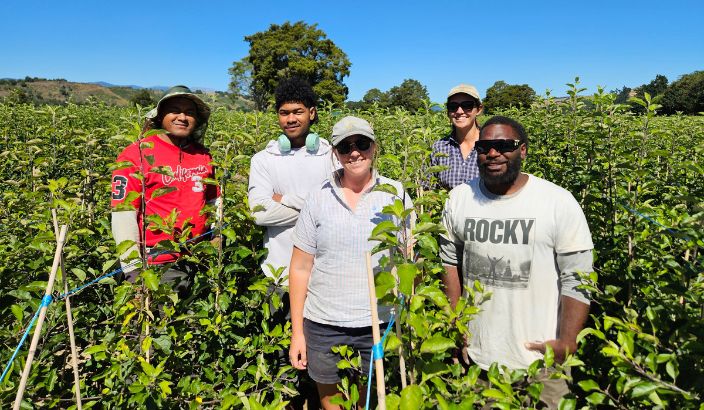Apple trees spark curiosity in Brightwater

Waimea Nurseries workers Loami Taulani, left, Kuli Taufa, Sarah Thomson, Jade Fekkes, and Georgie Fred have been part of the team growing two hundred thousand apple trees in Brightwater. Photo: Supplied.
Paddocks of young apple trees along Brightwater’s Clover Rd has locals curious about the quantity and their destination. So, Waimea Weekly set out to find some answers.
“Two hundred thousand young apple trees are growing there,” says Kate Marshall from Waimea Nurseries.
The trees are premium apple varieties destined to suit the Asian market. The trees are grown for one year before being lifted and sent to orchards in Hawke’s Bay, Gisborne, and locally in Tasman. The lifting process, which will take place this winter, happens when the trees go dormant.
Kate explains that a large percentage of the trees will be sent to Hawke’s Bay, a central hub for New Zealand’s apple industry, which produces around 60 per cent of the country’s apples.
Once the trees are removed, the land will be planted with cover crops. Typically, a variety of cover crops are planted for two years before being used again for apple production.
Kate reports that over the past five years, there’s been an increase in the popularity of apple trees with two leaders (trunks), as opposed to the traditional one-leader trunk.
“In some situations, you can either plant more trees or plant fewer trees that have two leaders. A two-leader tree increases productivity as the tree can make more fruit,” Kate explains.
“However, two leaders do need to be spaced slightly further apart and are not suitable for all varieties.”
The 200,000 trees include a mix of both single and two-leader varieties. As the young trees continue to grow, they represent the potential for local and international apple production as well as the adaptability to new growing techniques.
